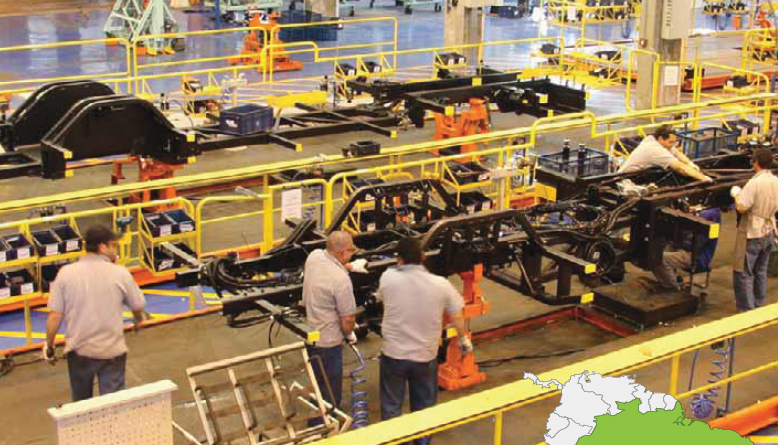
Brazilian manufacturing chiefs from GM, PSA and Daimler reveal the key factors supporting record production figures - and whether those numbers are sustainable
The retail prices of new cars in Brazil have, like a lot of other products, been on the increase. But even as prices have steadily risen, sales have exceeded all expectations. This is because that while new vehicle prices have increased by approximately 30% over the past five years, the cost of credit has been similarly reduced. Local interest rates would still be considered punitive in the United States or Europe, but financing is now considerably cheaper than even a year ago. It's fair to say that there's a local credit war going on, and everyone in the vehicle supply chain, from the manufacturer to end consumer, is ultimately set to be the winner. It is a situation that has buoyed the local economy. While the rest of the world was taking a financial beating, Brazil suffered the shortest downturn of any manufacturing market. José Eugénio Pinheiro, GM's Vice-President of Manufacturing, South America, says that a quick response by the national government was the reason for the rapid local recovery. ¨The government put some incentives in the market, exempting new cars from the IPI excise tax. This translated to about a 7% reduction in car prices. We are back on track, with high volumes and people buying.¨
Asked if the current level of sales is sustainable, Pinheiro says that while the IPI rebate ended in March, he doesn't see this having a dramatic affect on the market. In fact, the only thing that might have an adverse affect on current car sales and production could be a tightening of global credit, though even this would only have a limited local impact. Pinheiro: ¨What saved the (Brazilian) automotive sector was not exports but the local market. Like China, we are not a big exporter in the automotive sector. The Chinese are great producers, but so far for local consumption. We are in a similar situation.¨
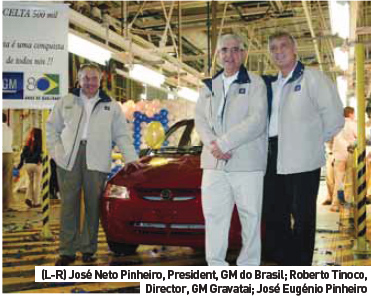 GM, though, does move cars through the region by way of its Mercosul partners. ¨We have a plant in Argentina that exports cars to Brazil and some of our cars are sold in Argentina. There is a good inflow and outflow of products from both countries. We have been exporting and importing products from Mexico under the trade agreement we have with them. So it's part of the plan with the countries we have a free trade agreement.¨ Additionally, unlike Chinese products, Brazilian-made cars do not have to battle the stigma of inferior quality. ¨Brazilian products are highquality, global products,¨ says Pinheiro. ¨If you visit my plants here, I challenge you to compare them to any other plant in Europe or North America, you will not notice a difference. The products are the same, the processes, the GMS (General Motors Manufacturing System). The culture for quality and cost reduction and elimination of waste, it's all there. We are proud of the quality.¨
GM, though, does move cars through the region by way of its Mercosul partners. ¨We have a plant in Argentina that exports cars to Brazil and some of our cars are sold in Argentina. There is a good inflow and outflow of products from both countries. We have been exporting and importing products from Mexico under the trade agreement we have with them. So it's part of the plan with the countries we have a free trade agreement.¨ Additionally, unlike Chinese products, Brazilian-made cars do not have to battle the stigma of inferior quality. ¨Brazilian products are highquality, global products,¨ says Pinheiro. ¨If you visit my plants here, I challenge you to compare them to any other plant in Europe or North America, you will not notice a difference. The products are the same, the processes, the GMS (General Motors Manufacturing System). The culture for quality and cost reduction and elimination of waste, it's all there. We are proud of the quality.¨
GM production set-up
In his role, José Eugénio Pinheiro is responsible for manufacturing operations across Brazil, while also having support responsibilities for GM plants in Argentina, Equador, Colombia and Venezuela. ¨The way we are organized, the manufacturing engineering team that we have here reports to global manufacturing engineering. But locally, I am responsible for them. We are responsible for the design of the processes, specification of the equipment, design and purchase of the tooling, and the (future) requirements for product expansion. It all comes under manufacturing.¨
Headquartered at its production facility in São Caetano do Sul, south of greater São Paulo, GM operates further Brazilian plants in São Jose dos Campos, Mogi das Cruzes and Gravatai, each of which is undergoing various updates as part of a R$5bn ($2.2bn) improvement plan designed to further streamline production and prepare for new products. Additionally, the company is currently constructing a new engine and transmission plant in Joinville and has recently completed a R$170m design and technology centre.
Pinheiro says that, while the funding was all locally sourced, the investments were made while GM elsewhere was in turmoil. ¨Chapter 11 was being discussed in North America and we were announcing huge investments. We were concerned that Chapter 11 in the US would have an impact on the market here. Chevrolet has a strong image here in Brazil and we worked to protect it. We produced and the dealers sold everything, we were able to isolate ourselves from the problem. We had our best ever month in the same month Chapter 11 was announced in the US.¨
Having been in operation for 80 years, GM's São Caetano plant is the oldest automotive production facility in Brazil. Gravatai, on the other hand, is only 10 years old. Currently undergoing a R$2bn refit, Pinheiro says that it is one of the leanest GM plants anywhere in the world. Producing up to 230,000 units per annum, a number which will increase once the on-going updates are completed, 16 key suppliers are located around the site, assembling modular systems that include seats, cockpits, wheels and tires, and completing engine and door dress up. Modules are delivered just-intime and just-in-sequence as vehicles are assembled.
Modules
Pinheiro says that from a production aspect, he is a firm advocate of modular production. He says that in addition to the advantage of not having to deal with thousands of additional part numbers, with parts only differing in colour and specification, modularization is being further advanced by the introduction of vehicles designed to take advantage of a modular production process. ¨We have been working with (our suppliers) for 10 years now at Gravatai, we have produced almost 1.5m cars. That's a good partnership.¨ Use of modules in automotive production is not only convenient, it also saves money, which Pinheiro says is at the very heart of successful production in Brazil. ¨We used to have our own foundry and casting facilities in São Jose, an iron park. But we stopped that and moved production out to local suppliers. It's not our core, building cars is our core. If you maintain a foundry, you need to drive the investment, keep the machines running, update the machines and processes – it all costs money. We decided that our money should be in the final product and all the money needed to develop castings should be with the castings supplier. It's their core, they think and breathe castings, while we should focus on the cars.¨
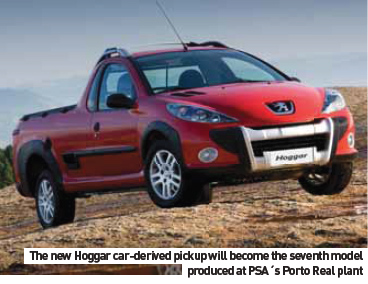 The Joinville engine and transmission plant is a further case of castings being delivered by suppliers, the site having existing foundries located nearby. ¨We will receive the castings, machine them, assemble the engines and ship to Gravatai. Joinville is well-placed between existing plants. It's difficult to justify the investment for a foundry, unless the logistics costs are absurd.¨
The Joinville engine and transmission plant is a further case of castings being delivered by suppliers, the site having existing foundries located nearby. ¨We will receive the castings, machine them, assemble the engines and ship to Gravatai. Joinville is well-placed between existing plants. It's difficult to justify the investment for a foundry, unless the logistics costs are absurd.¨
Pinheiro says that it is possible to further optimise the production process. ¨If I can find all the problems I have right now and fix them, I may even be able to produce more, or the same at a lower cost. As there has been great demand, I would like to produce more. And when I produce more and keep the fixed cost, my total average cost is reduced. That's what we have been able to deliver over the last five or six years.¨
As might be expected in a country where manual and automated processes command an equal share of total production, labour costs are a considerable portion of overall expenditure. Unlike the United States and other countries, which have national trades unions, Pinheiro says that Brazilian unions are organized by city. ¨This is a very competitive market and labour costs vary from region to region. I have a union here in São Caetano and I have different unions in the other plants. We have been here in São Caetano for 80 years and in Gravatai for only for 10 years. So in 10 years, we were the only one in southern Brazil, so the average labour cost is lower there than here, which means my average production cost is naturally lower there than here. Although I have made all this progress (at São Caetano), it is still not necessarily as competitive.
Going global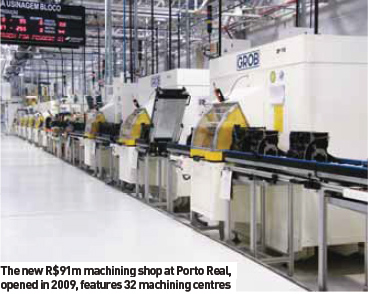
José Eugénio Pinheiro was a member of the team that drafted the original paperwork outlining the plan for GM to have one common, global manufacturing system. ¨We had teams in Europe and North America developing what we know as lean manufacturing. Those (areas) were the two big drivers, but I was representing Brazil and our region in those discussions. I cannot say exactly what in the GMS is from Brazil, but the first set of principles, elements, criteria, requirements, were developed together and we were part of that.¨
Pinheiro says that everything they learned about lean manufacturing was applied at the company's plant in Eisenach, Germany. ¨That was back in the early ´90s and it is still one of our best plants.¨ He goes on explain how NUMMI, the GM joint-venture with Toyota based in Freemont, California, was also a source of lean initiatives. ¨We brought a lot of lessons back from NUMMI and used them here. That was 20 years ago. We received visitors from NUMMI and Toyota Japan, and they mentioned a few times that we were the only plant that really understood and applied the TPS (Toyota Production System). We became a plant for the advisors at NUMMI to see a brownfield that had learned and implemented the concepts. Some of those elements became part of the GMS.
¨You can go to any GM plant anywhere in the world and you will see the GMS being applied in the same way. Egypt, China, Japan, Korea. In these countries I can't read the boards, but I can see that the plant is doing OK, because it's that clear. The plant talks to you. That's the beauty of the GMS.¨
Rapid response
Although the Brazilian market made a quick recovery from what threatened to be a deeper local downturn, the country has gone through previous market transitions that severely affected automotive production.
Pinheiro points out that it is perhaps the size of the local market that allowed it to bounce back so quickly. ¨There is a benefit to being smaller than North America or Europe, we can react faster.¨ Pinheiro closely watches local vehicle registration data, using it to tailor his production. But will this help if the market takes another dramatic downturn? ¨If the market drops 10%, I can handle that. If it drops 50%, well, then we have a problem. But what are the odds of it falling 50%? Ten per cent may happen, 15%, those are numbers we can easily manage. But nowhere in the world can there be a huge drop in the market and there be no impact on the organization.¨
Essentially, Pinheiro is advocating financial austerity, even when sales are on the upturn and there is money available. ¨If you restrain your spending, you make more money and then you can invest R$5bn in new products to guarantee extended success and maybe more jobs.¨ But, he admits, they are currently in a good position. ¨March was a great month, 140,000 cars. Analyse that and it means the industry is at about 3.4 or 3.5m for the year. It's good to be growing, it's a good problem to have.¨
PSA Group
Like GM, Peugeot Citroën do Brasil is manufacturing and selling in record numbers. To meet market demand, the company´s Porto Real facility (located about two hours outside Rio de Janeiro) is undergoing a series of additions as part of a R$1.4bn ($520m) programme in order to achieve a total annual capacity of 220,000 units. ¨The welding (BIW) building already has a new (third) line,¨ says Tarcísio Telles, Plant Director. ¨There is a new line in the assembly area and we will add a second line in the paintshop.¨ In addition to this, the plant now features a new machine shop, which supplies parts for the 220,000 (increasing to about 300,000 by 2012) 1.4- and 1.6-litre engines produced annually that were previously assembled from parts delivered by both French and local suppliers.
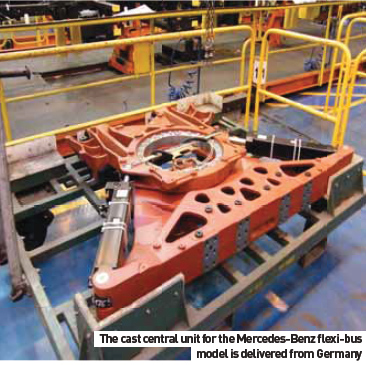 ¨We started production in 2001 with an investment to produce 22 vehicles per hour,¨ says Telles. ¨We are now up to 29 per hour, with no investment. Working three shifts, there's no way up without investing in capacity, meaning we have to invest in the paintshop, the bottleneck of all plants. If we double paintshop output, we can then go beyond incremental capacity increases.¨ He says, though, that automation will only be adopted with new models and where necessary. The seventh model to be produced at the plant, the 207-based Hoggar pickup, has seen automation added to the paintshop to address complexitites in the paint process. On the other hand, welding on the new BIW is still predominantly completed by hand, with the work checked by automated metrology stations on the line.
¨We started production in 2001 with an investment to produce 22 vehicles per hour,¨ says Telles. ¨We are now up to 29 per hour, with no investment. Working three shifts, there's no way up without investing in capacity, meaning we have to invest in the paintshop, the bottleneck of all plants. If we double paintshop output, we can then go beyond incremental capacity increases.¨ He says, though, that automation will only be adopted with new models and where necessary. The seventh model to be produced at the plant, the 207-based Hoggar pickup, has seen automation added to the paintshop to address complexitites in the paint process. On the other hand, welding on the new BIW is still predominantly completed by hand, with the work checked by automated metrology stations on the line.
Implementing efficiencies
Telles says that when he took over the plant in 2005 he implemented an on-going series of Kaizens, the first of which improved production on Line 2 in the assembly area by 40%. ¨We are now going further with individual Kaizens. My goal is to have 20 Kaizens implemented per person per year.¨ With 4,000 employees, that means 80,000 ideas per year, but Telles says that if implemented Kaizens result in lay-offs, those people would join a team designated to implement further Kaizens. ¨Most people count ideas. I count ideas implemented. An idea that is not implemented has no value.¨
Like José Eugénio Pinheiro at GM, Tarcísio Telles says that the national government played a big part in quickly turning around the Brazilian economy. ¨Government policies incentivising credit were very clever, allowing people lower on the economic ladder to move up. This has supported the market. People who could never have dreamed of having a new car can now purchase that car. This built confidence in the market.¨
According to government reports, the Brazilian middle class is expected to grow by 20 million people over the next six years, those lower down the socio-economic scale moving up due to improved availability of jobs and education. It is, says Telles, the equivalent of 30% growth in a developed economy, a country the size of Portugal where every resident is looking to buy a new car.
He goes on to say that if the market remains on the same upward trend, the newly-expanded plant will reach capacity in between five and 10 years. But what if the anticipated growth does not happen as planned? ¨In the short term we are OK. Even with the third shift, if the market goes down, we can reduce to two shifts. But (with the capacity investment) we will still need more people to run the two shifts than we had previously. Working in the Brazilian car industry, I know we will have another crisis. I don't know how long it will be, but it is coming. The economy is like that, things can change quickly and dramatically.¨
Mercedes-Benz do Brasil
Unlike GM and PSA, which are constantly preparing for the inevitable market downturn, Mercedes-Benz do Brasil, located in São Bernardo do Campo, near São Paulo, is more isolated from local market trends as it supplies engines and bus chassis to a wide range of countries and regions. ¨We are the world's largest manufacturer of bus chassis,¨ says Ricardo José da Silva, Vice-President (Bus), Latin America. ¨We build chassis for all types - city, intercity, coaches. From our portfolio, we can meet most customer demands in Latin America, including Mexico, but also worldwide, including Australia, Indonesia, Africa and parts of Europe.¨ Da Silva goes on to explain that there is not a great demand in Europe for their products as the region is more of an integral (full-build) bus market, supported by plants in Manheim and Istanbul.
In addition to the chassis portfolio, customer requirements can also be taken into account during the build process. For 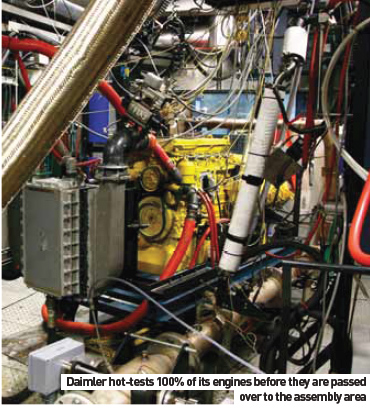 example, a Colombian order required that the finished chassis be Euro IV specification, despite this not being a requirement until 2013. ¨(The Colombians) now want to have Euro IV from 2011, two years earlier than expected. It won't be easy, but we try to meet the customer demands. We have a great development area and a well-organized production area, so we can do a lot things, prepare and change in a very short time.¨
example, a Colombian order required that the finished chassis be Euro IV specification, despite this not being a requirement until 2013. ¨(The Colombians) now want to have Euro IV from 2011, two years earlier than expected. It won't be easy, but we try to meet the customer demands. We have a great development area and a well-organized production area, so we can do a lot things, prepare and change in a very short time.¨
Each new emissions requirement demands cleaner fuel. Is that level of diesel available in Brazil and other countries? ¨To run Euro IV or Euro V, you need diesel with 50ppm of sulphur,¨ says Da Silva. ¨In Latin America, you find 2,000ppm of sulphur. The government and fuel companies are working to produce refined diesel, first 500ppm, then 250, then 50. In Brazil, we are going to jump from Euro III to Euro V. This will start in 2012. We are in test phases with different fuels. Most Latin American countries will switch in 2012 and 2013.¨
Da Silva continues by saying that while there are no plans as yet to develop an ethanol-powered bus (the fuel requiring a hot-cycle engine), there are plans to develop a biodiesel fuel that uses sugarcane derivatives. As for hybrids, he believes there is still no opportunity for these powertrain solutions. ¨Although we offer them elsewhere, hybrids are not economically feasible for countries in Latin America. Instead, we are trying to improve our fuel consumption levels, introducing new products. Today, we are the best in terms of fuel consumption and addressing environmental concerns.¨
Engine and chassis production
Daimler recently announced it had passed the 2.5m engines produced mark. ¨There are three engine lines, two producing both light and medium engines and the third producing our heavy engine,¨ says Jose Ricardo Bocciardi, Supervisor for Planning and Production. ¨All the engines are hot tested. We test temperature, torque and engine systems using proprietary software. If it passes, it goes through to the assembly line. If not, it is passed back for testing.¨ As Mercedes-Benz only produces manual bus transmissions, customers can choose from a variety of automatic transmissions supplied by companies such as Allison, ZF, Voith and Eaton. Another point of interest is that while most engines feature a black finish, those bound for the US market are finished in silver, to suit customer tastes. The chassis line is arranged in what Bocciardi describes as a 'fishbone' set up, designed to allow ease of access for what are predictably large sections and modules. ¨Our chassis are made in five modules, driving position, front axle, intermediate, rear axle and engine. All this comes together to make the bus. The intermediate part can be of varying length, to suit the model.¨
Bocciardi goes on to explain that of the two types of chassis, the one used for front-engined city busses is immediately welded in the middle, as these vehicles will not change in length. All other models are rear-engined (and feature uprated air suspension systems), and are bolted together before being welded with the correct length of centre module. Welding at Daimler has recently undergone an upgrade, says Bocciardi. ¨All the MIG-MAG welding is carried out manually, using Fronius and Merkle equipment, but the machines themselves are computer controlled. The machine follows the quality parameters of the welding processes. If something falls outside set levels, orange and then red lights alert the supervisor. A change in the voltage or gas flow can trigger an alert, or if a welder welds too fast, the tension deviates from normal. With this equipment, we can guarantee our welds.¨
Once the chassis is welded, it is taken by an AGV featuring SICK sensors to the paintshop. There degreaser is applied at about 80oC and between six and 8 bar of pressure. The chassis is then rinsed with deionised water and then with phosphates at 10 bar, before it is dried, the chassis rotating in the oven to improve drainage. The final step is to apply inner wax and outer sealants.
The finished chassis is then moved via crane to the 26-station assembly line, where additional modules such as the driver's compartment are added after powertrain marriage. All models run on the same line, including the 22m flexibus, which uses a cast centre joining module imported from Germany – one of the few parts not made in Brazil.
Da Silva comments on the cost-per-chassis: ¨If you compare with Europe, we have a cheaper chassis. Compare with Indonesia, their chassis are less expensive, but they do not have the required technology, so we supply some parts. This year, we started supplying parts to India. It's cheaper to build a chassis there, but the materials are not up to our quality and cannot return the same longevity.¨ In a price-sensitive market such as Brazil, how does Daimler compete with other chassis manufacturers, VW, Scania, Volvo and local company Agrale. ¨We have the best quality. The operational costs of Mercedes-Benz chassis are lower than the others. Our customers can use our chassis for many thousands of kilometers more than those of our competitors and then there's the resale value. In big cities here, busses must be changed every five years. A five-year old Mercedes bus is still a good bus which offers a good return.
¨There are about 450,000 busses running in Brazil today,¨ continues Da Silva. ¨Between 70 and 80% of these are Daimler. We have been in Brazil for over 50 years. The newcomers arrived in the 1990s, but we still have over 50% of the Brazilian market.¨






































